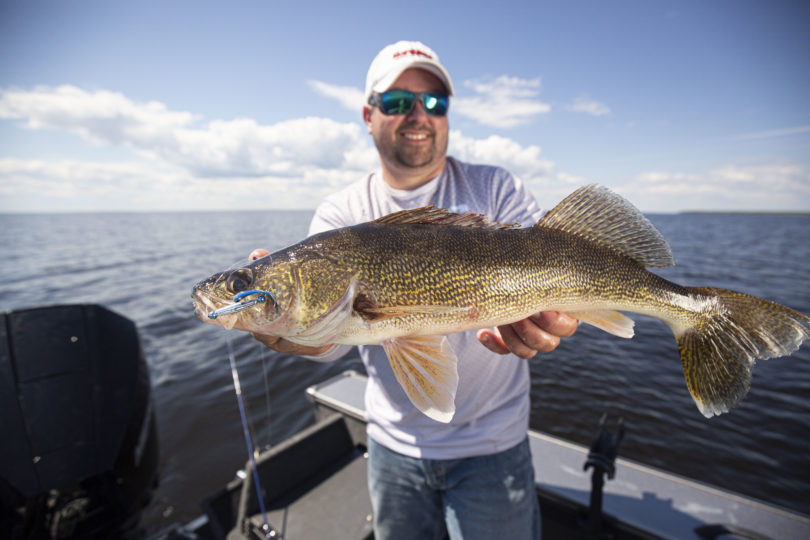
There are a lot of ways to catch fish during the dog-days of summer, you know those lazy summer months, but it’s worth remembering that fish are pretty fat and happy right now. Weedlines are well defined, bait is plentiful in most lakes, and warm water temps mean fish are at peak metabolism. While they need to eat often, it’s not hard to find a great place to get dinner. The menu options are varied as well, so it tends to take most fishing patterns and nullify the amplitude of their effectiveness.
What do I mean by that? Well, in any one lake there can be a top one or two ways to catch walleyes for example for any given season. What happens in summer is that with such a wide variety of bait, at a number of different zones and cover types, rather than one or two techniques, you often have about 5 of them which all produce, just not gangbusters as they might’ve during other parts of the season. That’s why I like to employ tactics that cross over to a number of different species and work well in a variety of situations.
Spinner fishing, pulling crawler harnesses, bottom-bouncing – whatever you want to call it – is to be among the best of the best for maximum action no matter where you fish. I was just talking with Ted Takasaki, noted tournament angler and Hall of Famer, about pulling spinners. “I pull them everywhere I go, from Erie to Winnipeg, to Sakakawea, and I’ve won tournaments with them over the past few decades everywhere in between.” Ted was also quick to point out that it’s a big-fish technique too, and he readily uses them to target trophies as well.
While Ted was talking specifically about walleye-fishing, we both agreed that some of our best panfish catches have been on spinners. Largemouth and smallies both love to eat-‘em, and while it can be frustrating, pike will clip hooks and readily slam a spinner as well. If it swims, it’ll eat a crawler or leech rigged behind a spinner and weight system. That includes rough fish which to many folks aren’t of interest, but really put up a fight and make for some action-packed days when other species aren’t going. Most often for me, that’s drum or “sheephead,” and they can really save a day when kids are losing interest and too much time passes between bites.
The question I think has less to do with “if,” but “why?” Ted chimed in here too, saying that “It’s tough for most fish to pass up the combination of live bait, presented at some speed, with the attraction of vibration, flash, and color.” Spinners really have a lot going for them in that regard, as few lure classes check as many boxes as these live-bait delivery systems can. Vibration draws fish from distance, and so does flash or color, while live bait seals the deal for a strike.
Color can be an overlooked portion of the system, as there are plenty to choose from, as well as standards like hammered nickel and gold. Yet, in a bug hatch situation for walleyes, it’s nice to match the hatch, with browns, greys, and other subdued colors with a copper or hammered gold blade really being a top producer. Again, worms really help elicit strikes, as lots of fish will follow baits without striking, especially at sub-1 mph speeds.
Regarding pace, it’s nice to pull standard spinners at that 1 – 1.5 mph GPS speed, but it’s even nicer to pull polycarbonate “butterfly” style blades at whatever speed you’d like. I’m often glued to the electronics, pulling along at a decent pace, then see a glob of fish to slow down on. If dropping it in their face isn’t getting the job done, I’ll actually try picking up the pace to see if faster doesn’t create some more urgency and elicit reaction strikes.
I tend to use bottom-bouncers as the weight of the choice, especially in water deeper than 15 feet, as they’re relatively snag-proof and really easy to use. A good bottom bouncer rod and some hard-line (braid) will telegraph bottom composition up that steel wire and to your fingertips, giving you valuable information on the underwater real-estate. As a general rule of thumb, 2 oz bottom bouncers are good in that 18-25 FOW mark. Feel free to go up to 2.5-3oz. weights in depths to 30 FOW, while pulling out the smaller ones only in 10-15 FOW.
In those instances, however, most often I’m fishing around weeds, where I like to use simple bullet-nose sinkers. Whether after gills and crappies, or walleyes in the weeds, anytime there’s standing cabbage or coontail, I’ll be using bullet-nose bass-style weights to meander through stalks. If it’s walleyes, I’m looking for wind-blown cabbage areas with sparse pockets and patches. I’ll pull right through it, and you’d be amazed at how walleyes will come up and out of the weeds to hit an overhead bait.
In smaller natural lakes with all kinds of weed growth, I just try to use a heavier style bullet-nose weight and stick to the outside edge. Here, you’ll find all kinds of roaming predators, some of the biggest panfish in the lake, and all kinds of species you may have never thought would eat a spinner. So get a cooler to keep those crawlers cold, and employ as many lines as you can to go through various colors, sizes, baits, and styles while sticking to the outside edge of a break or weedline. Fishing doesn’t have to be complicated during the dog-days of summer, and sometimes just getting bit by anything is the order of the day.

